The crackle of electricity in the air still sends chills down my spine. Years ago, on the John Muir Trail, a sudden storm turned the sky into a battlefield—a sizzling reminder of nature’s raw power. Though the odds of being struck are slim (less than 1 in a million annually), when you’re exposed on a ridge, statistics don’t offer much comfort.
As a Wilderness First Responder with Colorado Trail experience, I’ve learned to treat storms like the wrath of Zeus—respect them, prepare, and know when to retreat. The National Weather Service and NOLS courses reinforced what that day taught me: planning and awareness save lives.
This guide shares hard-earned lessons—from reading weather patterns to choosing safer terrain—so you can enjoy the wild without fear. For more trail-tested advice, check out our companion piece on Essential Safety Tips for Hiking Colorado Trail.
Table of Contents
Key Takeaways
- Storms can strike fast—always check forecasts before heading out.
- Open ridges and peaks are high-risk zones; seek lower ground early.
- Carry a weather radio or app for real-time alerts.
- If caught outside, avoid isolated trees and water.
- Wait 30 minutes after the last thunderclap before resuming your hike.
Understanding the Risks of Lightning While Hiking
The moment I saw my hair stand on end like static-charged wires, I knew trouble was brewing. That’s nature’s way of screaming “Get down now!”—a lesson hammered into me during a summer monsoon near Maroon Bells. To stay safe, you need to understand how lightning works and why hikers are prime targets.
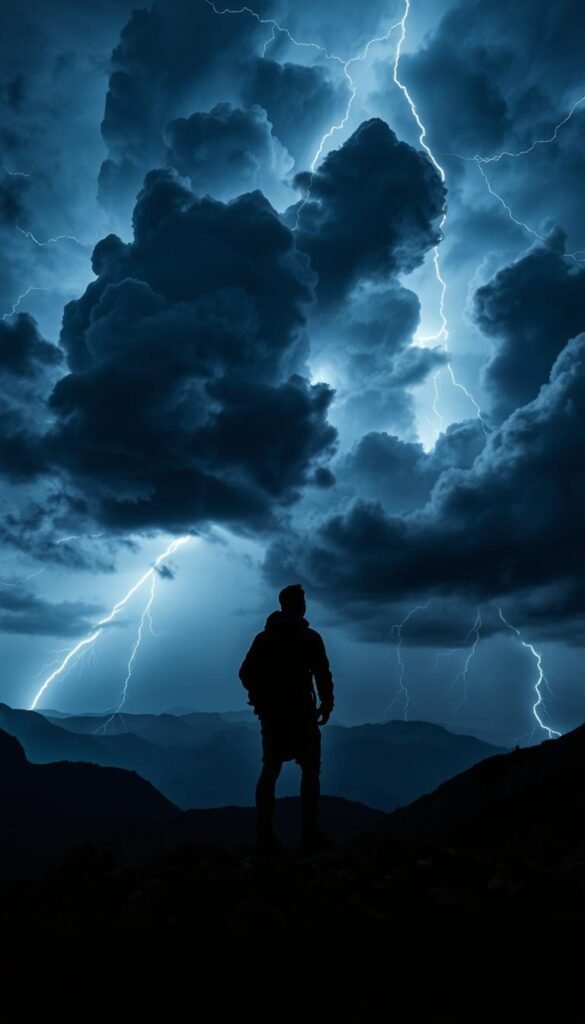
What is Lightning and How Does It Form?
Picture shaking a soda bottle—the collisions inside create pressure until the cap flies off. Lightning works similarly. When ice particles in storm clouds collide, they build an electric charge. At 50,000°F (hotter than the sun’s surface!), that energy explodes as a bolt seeking the fastest path to ground.
Thunder is your early-warning system. Count seconds between the flash and boom—each five-second gap means the storm is one mile away. If it’s under 30 seconds, you’re in the danger zone.
Why Hikers Are at Risk
Elevation multiplies threats. At 11,000 feet in Colorado, you’re often the tallest object—unlike Florida’s coastal trails where palms divert strikes. The National Weather Service rates backcountry terrain safety on a 0-10 scale; most alpine routes score a risky 7+.
Four strike types dominate:
- Ground current (50% of deaths): Energy spreads through wet earth.
- Side flashes: Bolt jumps from nearby trees.
- Direct hits (rarest but deadliest).
NOAA data shows Southeastern states have the highest lightning density, but Rockies’ afternoon storms are predictable. Remember: tents offer no protection, and metal gear (like trekking poles) conducts—but doesn’t attract—strikes.
If your scalp tingles or hair lifts, a strike is imminent. Move immediately—90% survive, but cardiac arrest and nerve damage are real risks. The CDC confirms ground current causes most fatalities, especially in groups clustered near water.
Planning Ahead: Weather Forecasts and Timing
Clouds can lie. That’s what I learned when a sunny Colorado morning turned deadly in minutes. Now, I treat forecasts like gospel—with a backup plan. Mountains create their own weather, and understanding these patterns separates prepared hikers from cautionary tales.

Checking Weather Forecasts Before Your Hike
Generic apps won’t cut it. I rely on weather.gov radar loops and satellite communicators like Garmin inReach for real-time updates. Here’s my ritual:
- 72 hours out: Scan for thunderstorm risks. Monsoon season (July–Sept in the Rockies) demands extra caution.
- Trailhead check: Look for anabatic winds—warm air rising up slopes often triggers afternoon storms.
- 30-30 Rule: If thunder follows lightning within 30 seconds, the storm is 6 miles away. Seek shelter immediately.
Understanding Mountain Weather Patterns
In the Sierra, lenticular clouds (smooth, lens-shaped) mean high winds. But cumulonimbus—towering, cauliflower-like clouds—spell trouble. My Long’s Peak strategy? Start at 2 AM to descend before noon, when 80% of weather strikes hit.
Microclimates vary wildly. Appalachian humidity fuels all-day rain, while Rockies’ thin air brews fast thunderstorms. Reverse-plan campsites: pitch tents lower if forecasts show evening systems rolling in.
Pro tip: SPOT devices lack NOAA integration. For live information, Garmin’s weather overlays are worth the splurge.
Choosing Safe Terrain to Minimize Risk
The map in my hands felt useless when the sky turned charcoal—terrain knowledge became my lifeline. During a storm, where you stand matters more than how fast you run. The National Weather Service rates zones from 0 (exposed ridges) to 3 (uniform tree groves). Learn these ratings like your trail name.
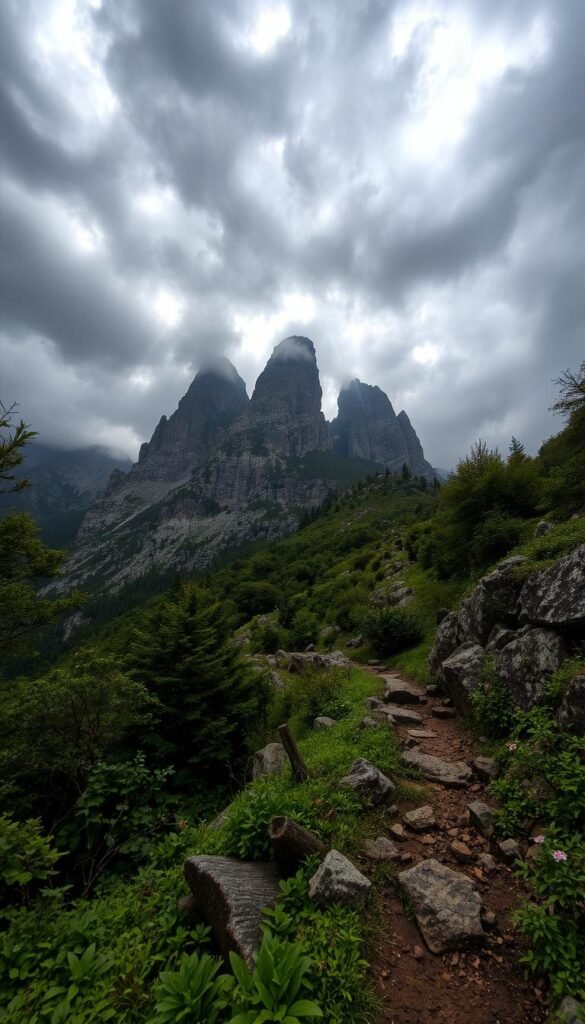
Identifying High-Risk Areas
High-risk areas are nature’s lightning rods. On the Colorado Trail, I watched a bolt vaporize a lone pine—a stark reminder. Avoid:
- Tall, isolated trees (they’re 50% more likely to be struck)
- Ridges and peaks (NWS score: 0)
- Caves (ground current funnels through openings)
In 2006, a group huddled near Vanderventer Shelter learned this tragically. Ground current surged through wet earth, proving tents offer false security.
Finding Safe Terrain During a Storm
Seek valleys or dense middle-height trees—their uniformity disperses energy. The “triangle method” works: pick a spot 50 feet from water, tall objects, and metal.
| Terrain Type | Safety Rating (0–3) | Example Trails |
|---|---|---|
| Exposed ridges | 0 | Pacific Crest Trail (High Sierra) |
| Dense tree groves | 3 | Appalachian Trail (Smokies) |
If trapped, crouch in a ditch—your body should touch only rubber-soled shoes. Spread out if hiking in a group; ground current jumps between close points.
What to Do When a Storm Approaches
A metallic tang in the air—like licking a battery—was my only warning before chaos erupted. Near Goodale Pass, that ozone smell meant lightning was close enough to taste. Storms move fast; hesitation kills. Here’s how to react when the sky turns hostile.
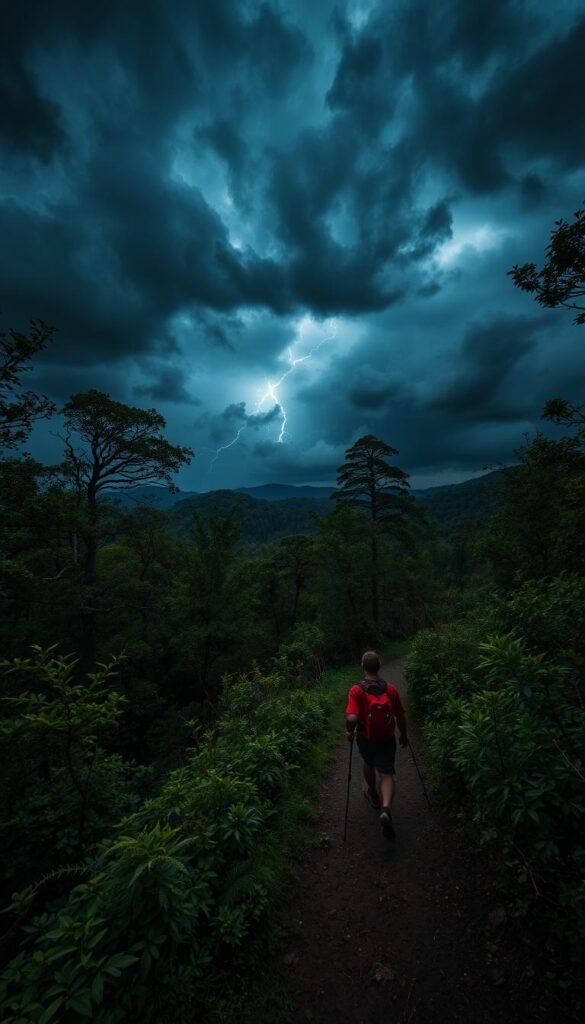
Recognizing the Signs of an Approaching Storm
Your body senses danger before your brain does. Hair standing on end? That’s static electricity—run. Other red flags:
- Thunder within 30 seconds of a flash (storm is 6 miles away)
- Sudden wind shifts or temperature drops
- Distant cumulonimbus clouds with anvil tops
In 1999, five hikers in Yosemite ignored these signs. A single strike killed one and injured the rest. Don’t wait for rain; by then, it’s often too late.
Immediate Actions to Take When Lightning is Near
Follow the 5 Cs protocol I learned guiding NOLS courses:
- Check time: Note the last thunderclap.
- Cover your head with a pack (not metal frames).
- Crouch on insulated soles, heels touching.
- Count seconds between flash and boom.
- Communicate using whistles (three sharp blasts = danger).
| Gear Priority | Action | Reason |
|---|---|---|
| Trekking poles | Drop immediately | Metal conducts current |
| Backpack | Use as insulation | Reduces ground contact |
Groups should spread 100 feet apart—cluster deaths from ground current are preventable. Wait 30 minutes after the last thunder to move. And if someone’s struck? CPR within 2 minutes boosts survival to 90%. Stay sharp; storms don’t negotiate.
Avoiding Lightning While Hiking: Key Safety Tips
The jagged scar on my favorite hiking boot tells the story—a near-miss with a strike that split a boulder 20 feet away. That day taught me survival isn’t about luck; it’s about smart choices. When electricity dances across the sky, your actions determine the outcome.
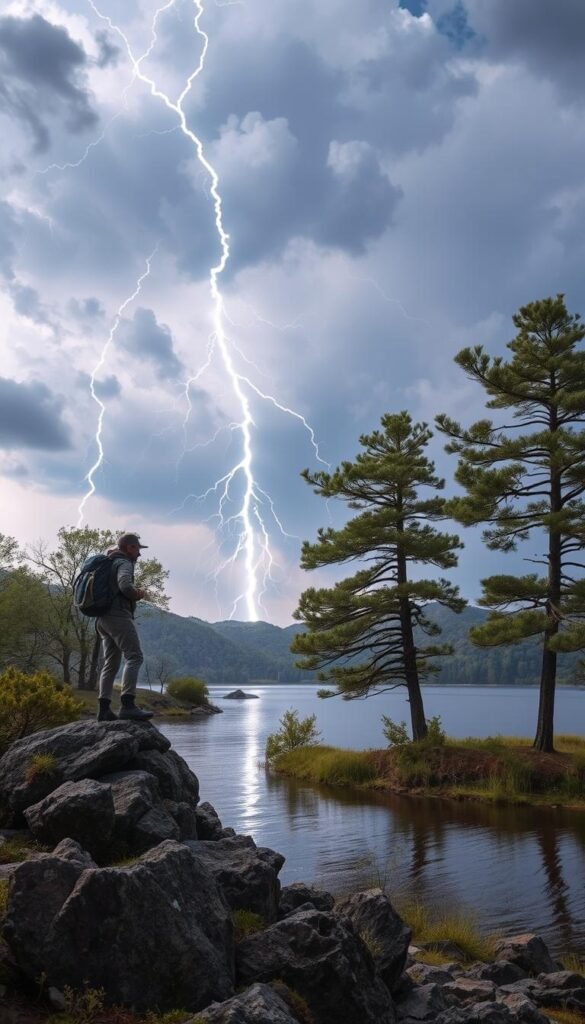
Smart Terrain Choices During Storms
Nature has its own hierarchy of risk. A lone pine stands like a beacon for lightning, while an aspen grove disperses energy safely. Remember:
- Avoid isolated trees—they’re 50% more likely to be hit (as seen in the tragic 2012 El Capitan incident involving camera gear).
- Dense middle-height trees offer better protection than open areas.
- Wet rocks conduct electricity 10x faster than dry ones—a key finding from Japanese researchers.
Handling Gear When Thunder Roars
Metal doesn’t attract strikes, but it conducts them brutally. My rule? Aluminum tent poles stay inside the pack, while carbon fiber gets stashed vertically. Follow this gear triangle for campsite safety:
- Store metal objects (poles, cookware) 50+ feet from sleeping areas.
- Use dry bags as insulation under your feet if caught exposed.
- Keep trekking poles horizontal on the ground—never planted upright.
Vehicles act as Faraday cages, but your tent offers zero protection. When NOAA alerts ping, I reorganize camp like chess pieces—water sources downstream, gear clustered by conductivity risk. For more advanced terrain strategies, explore The Trek’s lightning safety guide.
| Material | Risk Level | Action |
|---|---|---|
| Aluminum poles | High | Store inside pack |
| Carbon fiber | Medium | Keep separate from bodies |
| Rubber soles | Low | Use as insulation |
That 477-mile Mississippi megaflash in 2021 proved lightning defies expectations. Stay vigilant—storms can strike beyond audible thunder range. When in doubt, assume the position: crouched low, heels touching, head tucked like a turtle in its shell.
What to Do If You’re Caught in a Lightning Storm
My knees hit the dirt before my brain registered the ozone smell—a split-second decision that saved my life. When lightning threatens, hesitation kills. I’ve trained with NOLS and military survivalists; here’s how to react when the sky turns violent.
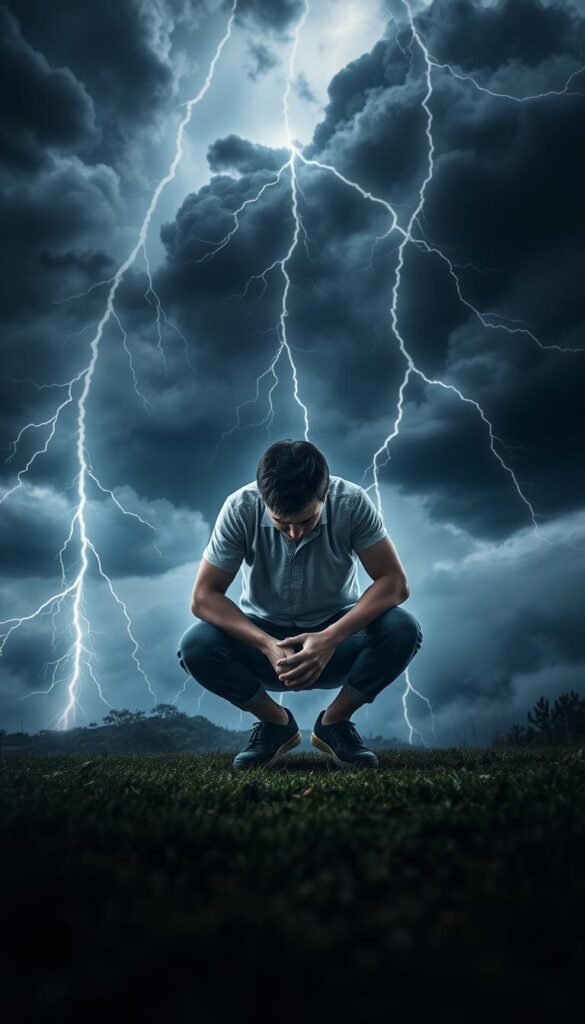
Assuming the Lightning Position
Forget Hollywood’s dramatic poses. The real position is unstable but effective: crouch on the balls of your feet, heels touching, head tucked low. This minimizes contact with the ground—where deadly current spreads.
In 2018, three hikers in the Grand Canyon survived a strike using this technique. Their secret? “Lightning yoga”: balancing on toes while gripping ankles. Pro tip: A sleeping pad won’t insulate you—NOLS debunked this myth after testing conductivity.
Spreading Out in a Group
Clustering is lethal. Yosemite SAR reports show ground current jumps between group members within 20 feet. Use this formula: 50 feet × (number of people). Military squads train to form staggered lines—like human lightning rods dispersing energy.
- Emergency tarps: Fold under feet to reduce ground contact (per 2021 Alpine Rescue study).
- Communication: Whistles override thunder. Three sharp blasts signal danger.
- Metal gear: Trekking poles go horizontal—never planted upright.
When seconds count, your body becomes the circuit breaker. Stay low, stay apart, and live to hike another day.
Conclusion
The adrenaline still pulses when I recall that storm—how quickly blue skies turned deadly. But knowledge transforms fear into confidence. Here’s what sticks with me:
Forecasts save lives. Trust tools like the GOES Health App (use code TRAIL20 for premium features). Storms move fast, but real-time information keeps you ahead.
Terrain matters. Valleys beat ridges, and dense trees trump open fields. Remember the NWS checklist: if you hear thunder, you’re already at risk.
For your next adventure, download a weather radar app and join our #WeatherWiseHiker challenge. Share your storm-smart tips—we’ll feature the best stories.
Stay tuned for our next guide: Snow Travel Safety. Until then, hike smart, and let Mike Lewinski’s electrifying sunset photo remind you—nature’s power is beautiful, but respect it.



0 Comments